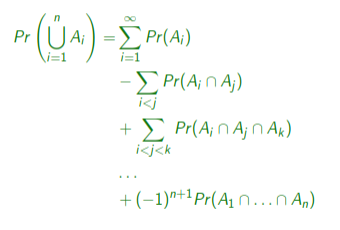4: Dimensional Analysis by Statistical Analysis
1/26
There's no tags or description
Looks like no tags are added yet.
Name | Mastery | Learn | Test | Matching | Spaced |
|---|
No study sessions yet.
27 Terms
Probability Function
Random variable X, f(xi) = Pr(X = xi)
Dense Sampling Set
A sampling space that’s uncountable and continuous.
Probability Density Function
For every closed interval xi = [a, b], where for all x, f(x) >= 0 and the integral of f(x) between negative infinity and infinity is 1.
S is a dense sampling space
Powerset(S) = {ci} and the powerset of all subsets of S
X: S → T is a dense random variable defined over S where T = {xi} and X(ci) = xi
![<p>For every closed interval x<sub>i</sub> = [a, b], where for all x, f(x) >= 0 and the integral of f(x) between negative infinity and infinity is 1.</p><ul><li><p>S is a dense sampling space</p></li><li><p><span>Powerset(S) = {c<sub>i</sub>} and the powerset of all subsets of S</span></p></li><li><p><span>X: S → T is a dense random variable defined over S where T = {x<sub>i</sub>} and X(c<sub>i</sub>) = x<sub>i</sub></span></p></li></ul><p></p>](https://knowt-user-attachments.s3.amazonaws.com/c97320dd-b780-4340-86df-d6ed779c9410.png)
Probability Density Function Properties
For all x, Pr(X = x) = 0
P(X >= a) = integral between infinity and a of f(x)
P(X <= a) = integral between a and negative infinity of f(x)
Cumulative Probability Distribution Function
F(x) = P(X <= x)
X is a random variable defined over a sampling space
Cumulative Probability Distribution Properties
Always increasing but not always monotonic - x1 < x2 → F(x1) <= F(x2)
lim(x → -inf.) F(x) = 0 and lim(x → inf.) F(x) = 1
Pr(X > x) = 1 - F(x)
x1 < x2 → Pr(x1 < X <= x2) = F(x2) - F(x1)
Note - F(x) is only continuous on the right-hand side, but not always on the left
Joint Distribution
A collection of probabilities over a series of random variables’ sampling spaces: Pr(X1 = cx1, j, …, Xn = cxn, k)
X are the random variables
n is the number of random variables
Powerset(Xi) = {cxi}
j and k indicate elements in x
Denoted as f(x, y)
Bivariate Distribution
Joint distribution where n = 2 (i.e. there are two random variables)
Contingency Tables
Frequency matrices that express joint frequences for 2 or more categorial variables.

Mutual exclusion (Disjoint)
Where two sets never contain common outcomes (A ∩ B = {}).
For more than two sets, for each pair of sets denoted by i, j where i ≠ j, Ai ∩ Aj = {}
Probability of a union of events

Probability of a union of disjoint events
Just a sum of all individual probabilities.
Probability of a union of two sets
P(A ∩ B) = P(A) + P(B) - P(A U B)
Independence of two sets
P(A ∩ B) = P(A) * P(B)
The occurrence of one event does not give us information about another event.
Statistically Independent Random Variables
The joint probability distribution function is factorisable in the form P(X, Y) = P(X) * P(Y)
Information contained in the occurrence of an event
I(ei) = -logb(P(ei)) = logb(1/P(ei))
Units of information
Depends on the base used:
Bits if 2
Hartleys if 10
Nats if e
Entropy
The average amount of information you get from the source - a measure of uncertainty.
Affected by statistical independence
The more common the event is, the less information it carries
Information (r.e. Entropy)
Resolves uncertainty, tells us more about a random variable.
Entropy Formula
H(X) = For all i, P(xi) * I(xi) = -(for all i, P(xi) * logbP(xi))
Joint Entropy Formula
H(X, Y) = -(for all xi in X (for all yj in Y (P(xi, yj) * logbP(xi, yj))))
Independent Component Analysis
Used to decompose a signal into statistically independent sources (bases).
In the formula Y = XB, ICA solves for both X and B at the same time.
Mathematically solving X ~= X^ = WY, W ~= B-1
Only produces approximations
Independent Component Analysis Formula (Long)
Observe J linear mixtures y1, … yj comprised of I = J sources x1, …, xi
For all j in J, B(1, j)x1 + B(2, j)x2 + … + B(i, j)xi
Independent Component Analysis Formula
Y = XB = for all i in I (sources), B(i, j)xi
Independent Component Analysis Limitations
Always assumes the components are mutually independent, mean-centred and have non-Gaussian distributions
Cannot identify the number of source signals or the proper scaling of them
Ignores sampling order (time dependency) and works over variables rather than signals
Solving for an estimation - assumption (ICA)
That the sources are mutually exclusive.
Solving for an estimation (ICA)
Maximising the joint entropy of X^, i.e. g(X^) = g(WY)
g(X^) is the cumulative density function of X^
Independence of sources is obtained by adjusting the mixing of W ~= B-1
This also maximises the mutual entropy, H(g(X^))
Then use gradient descent to take a small step in the direction of the gradient of H(g(X^))
Wnew = Wold + h * gradient(H(g(X^)))
h is the learning rate